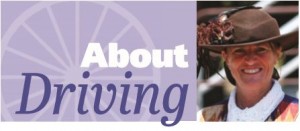 Every time I work with a new horse, I learn something. After getting to know the horse in the round pen, the first things I teach the horse is to walk, whoa , and to stand on command.
Every time I work with a new horse, I learn something. After getting to know the horse in the round pen, the first things I teach the horse is to walk, whoa , and to stand on command.
This introductory part of training is very important for building trust and mutual respect between horse and trainer. Time and patience is needed. Nothing will be gained if the trainer loses his patience and the horse gets frightened or resistant.
WHOA is the most important word a driving horse needs to know. It’s never used in driving to slow a horse — it means STOP all movement. Stand is the next important word your horse must learn. You stop at the stop sign, but the horse must stand until asked to move forward!
Working in the round pen. Put the horse on the rail, asking it to walk, be relaxed, and move in a 1-2-3-4 rhythm. Relaxation and rhythm are the first steps on the German Training Scale. From this point forward, in our driving training, we will pressure from behind and ask the horse to accept it without fear, as well as have the confidence to be out in front of us without trying to evade us. Now we start introducing the verbal whoa. Ask your horse to whoa at the walk while on the rail, using an authoritative voice, and draw out the tone of your voice. Long and low- Waaaaalk, whooooooa. These should be soothing and quiet, not abrupt. Just ask. It may take a couple of requests before your horse starts to listen to you- be patient.
You may want to pressure your horse to stop by stepping toward the rail, a few strides in front of your horse’s path, pointing your whip at the rail, and slowly raising your whip to act as a barrier. Be careful — your horse may run past you the first couple of tries as he starts to feel the pressure and feel the need to escape. You effectively stop his forward movement by creating pressure. As soon as the horse stops, step back slowly to release just enough pressure so he doesn’t turn around or scoot forward. Reward and repeat! Work both directions. When you have walk, whoa, stand, transitions, you can add “trot” and continue with transitions until your horse stops and stands with whoa, until you ask him to more forward again.
At this point, I also start to introduce adding blinders. I use a racing hood, so that I can remove the blinders, but not the bridle. I repeat the previous exercises. Now we find out if the equine knows the words, or is just reading your body language. Repeat until you have whoa, stand and walk.
Long lining. Once you and your equine both have confidence in round pen-free lounging, it’s time to add the long lines. I prefer to run my lines through the center rings on the surcingle instead of through the rein rings on the top. Why? The lower setting promotes a more relaxed self-carriage, and the pivot point is the “driver” and not the rein rings. (Think of a wheel hub: the driver as the spokes; the long lines and the outer rim of a wheel as the horse on the bend). You want to teach the equine to listen to his mouth. You must have a light but constant contact. Ask your equine to whoa verbally, and squeeze your hands creating resistance until the stop is achieved. Then ask for a stand(release the pressure gradually as the equine stands and relaxes). At first your horse may only stand a few seconds. Each time you ask for a whoa/stand, ask for a few seconds longer. I get great satisfaction when I have a horse that won’t stand in the beginning of a session, and by the end is so relaxed at the halt, I have to wake him up! Whoa/stand should be the horse’s “happy place,” where he is comfortable, balanced, and his energy is quiet.
Rewarding for good behavior. I find that many humans forget this part of training, as we get so focused upon the steps of daily training. This can be done by three methods of positive reinforcement: (1) touching, such as petting or brushing; (2) verbal: “good boy;” (3) food reward: small treats.
When your horse does what you ask, you should reward with one of the three methods each time. This is referred to as “operant” conditioning and “random” reward. Your horse will look forward to his reward, and for reassurance that he did his job correctly! Without getting a positive reinforcement of reward, your horse may become sullen or apathetic about learning and responding. You wouldn’t go to work if you didn’t get a paycheck! The happier you are about your horse, the happier your horse will be to do his job.
Whoa/stand is a judged gait in shows. You stand and whoa at a stop sign, or while chatting with a neighbor who admires your turnout. Make whoa/stand a part of your daily routine, whether riding or driving.
~Trish
Leave a Comment
All fields must be filled in to leave a message.